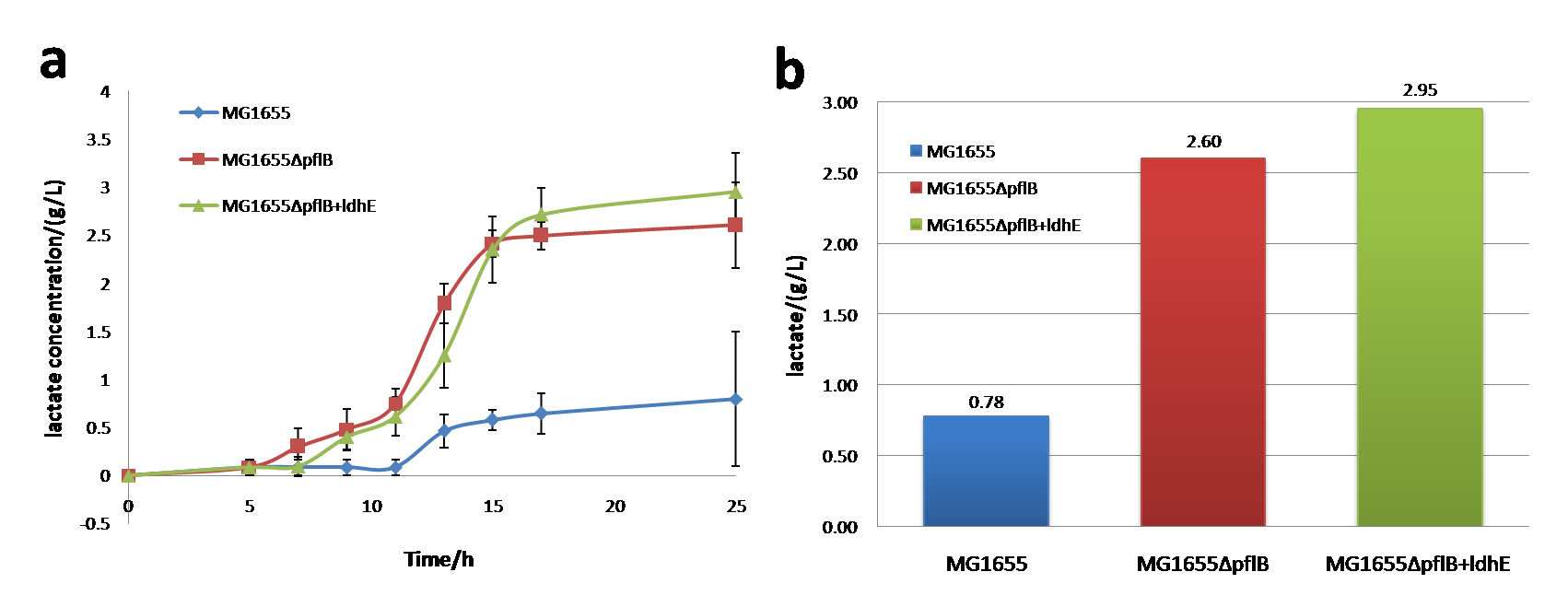Difference between revisions of "Team:TJU/Results"
| Line 174: | Line 174: | ||
<p>To prove the EC10 and EC10* work as expected, we conduct several experiments and the results are as follows.</p></br> | <p>To prove the EC10 and EC10* work as expected, we conduct several experiments and the results are as follows.</p></br> | ||
| + | <div class="kuang" style="width:570px"> | ||
| + | </br><a href="https://static.igem.org/mediawiki/2015/2/20/QQ%E5%9B%BE%E7%89%8720150918005538.jpg" target="_blank" ><img src= "https://static.igem.org/mediawiki/2015/2/20/QQ%E5%9B%BE%E7%89%8720150918005538.jpg" width="550" alt=""/></a> | ||
| + | <div id="Enlarge"> | ||
| + | <p> <b>Figure 3.</b> <span style="font-size: 14px"> The yield of riboflavin in different strains: EC10, Rf02S (Δ<span style="font-style: italic">pgi</span> + EC10), EC10*</span> | ||
| + | <a href="https://static.igem.org/mediawiki/2015/2/20/QQ%E5%9B%BE%E7%89%8720150918005538.jpg" target="_blank"><img src=" https://static.igem.org/mediawiki/2013/9/90/Enlarge.jpg " width="20" height="20" align="right" alt="" /></a></p></div></div></br> | ||
<p>As shown in figure 3, <span style="font-style: italic">E. coli</span> BL21 with EC10 reaches a final yield of 17 mg/L in tube cultivation. <span style="font-style: italic">E. coli</span> BL21Δ<span style="font-style: italic">pgi</span> + EC10 reaches 33 mg/L. <span style="font-style: italic">E. coli</span> BL21 + EC10* reaches 90 mg/L.</p></br> | <p>As shown in figure 3, <span style="font-style: italic">E. coli</span> BL21 with EC10 reaches a final yield of 17 mg/L in tube cultivation. <span style="font-style: italic">E. coli</span> BL21Δ<span style="font-style: italic">pgi</span> + EC10 reaches 33 mg/L. <span style="font-style: italic">E. coli</span> BL21 + EC10* reaches 90 mg/L.</p></br> | ||
Revision as of 08:56, 18 September 2015

Results
1 Lactate producing system
In order to verify our ldhE part and pflB knockout strategy have works well, we get following results.
Shown as figure 1a, under anaerobic conditions, wild-type MG1655 has the same growth rate as MG1655ΔpflB, but MG1655ΔpflB + ldhE keeps relatively lower growth rate than the two strains mentioned before. Shown as figure 1b, the anaerobic glucose consumption rate keeps the nearly same among MG1655, MG1655ΔpflB and MG1655ΔpflB + ldhE.
In anaerobic environment, lactate production of MG1655, MG1655ΔpflB and MG1655ΔpflB+ldhE has large differences between each other. Notably, knocking out of pflB together with ldhE insertion will increase lactate generation up to ~3 g/L and the amount produced by MG1655ΔpflB is smaller than MG1655ΔpflB+ldhE.
So, knocking out of pflB can dramatically improve the lactate production. Besides, ldhE also plays an important role in lactate increase. Engineered lactate producing strain (MG1655ΔpflB+ldhE) has a greater utilization of carbon sources and a higher yield of lactate with M9 medium under the same concentrations of glucose.
2 Flavins producing system
To prove the EC10 and EC10* work as expected, we conduct several experiments and the results are as follows.
As shown in figure 3, E. coli BL21 with EC10 reaches a final yield of 17 mg/L in tube cultivation. E. coli BL21Δpgi + EC10 reaches 33 mg/L. E. coli BL21 + EC10* reaches 90 mg/L.
3 Co-culture MFC -- Labor Division
Figure 12 13
The relations between current density and voltage is referred as polarization curve while the power curve can represent the relations between output power density and current density. We can learn from the fugure ***, the highest power density of (1) reaches 10 mW/m2 and (2) reaches 17 mW/m2.
Figure 14 15It is obvious that the power output in three-strain MFC systems with a more complete labor division are far greater than single-strain and two-strian MFCs.
Figure 16It has been shown in power curve that Shewanella + ΔplfB ldhE + B. Subtilis has a significantly higher output than Shewanella + ΔplfB ldhE + Rf02S, which indicates that three-species system can generate higher electricity and have a better MFC performance, in return, have a promising application.
E-mail: ggjyliuyue@gmail.com |Address: Building No.20, No.92 Weijin road, Tianjin University, China | Zip-cod: 300072
Copyright 2015@TJU iGEM Team





